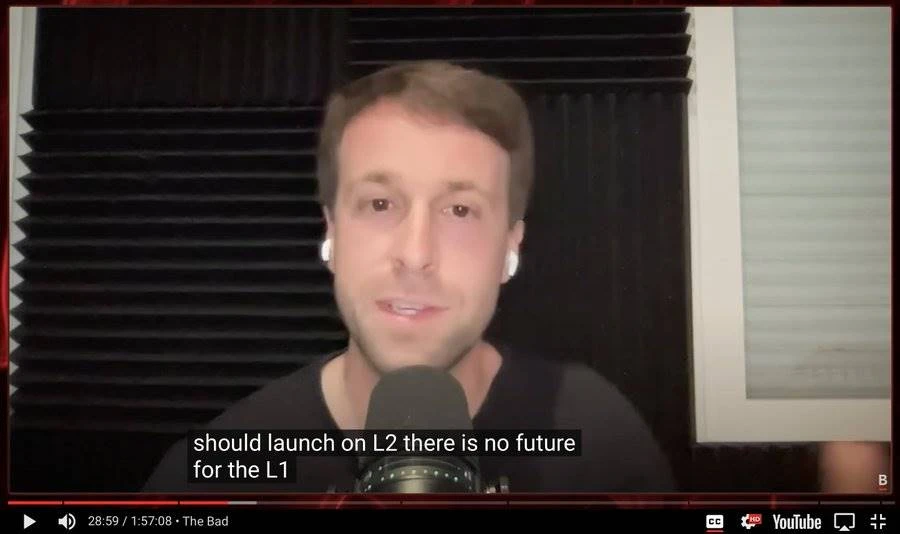Akun ekonomi ekspansi Ethereum: Apakah layak memberikan sebagian besar pendapatan penyortiran ke L2?
Penulis asli: Doug Colkitt
Terjemahan asli: TechFlow
This is a good analysis of Data Availability (DA), and the most reasonable bullish speculation for DA. However, I think it is impossible for DA to get close to 50% of L2 fees. Because from an economic structure point of view, the value accumulation of sorting always far exceeds DA.

The core business of blockchain is selling block space. Since block space is difficult to exchange between different chains, they almost form a monopoly.
However, not all monopolies can obtain excess profits. The key lies in whether prices can be differentiated for consumers.
Without price differentiation, monopoly profits are little different from commodity goods. Think of how airlines differentiate between price-conscious business travelers and budget-conscious consumers, or how the same SUV is sold at very different prices under the Volkswagen, Audi, and Lamborghini brands.
Priority fees are an extremely effective price differentiation mechanism in blockchains. The highest priority transactions pay fees far exceeding the median.

L2 and Solana achieve high throughput and high revenue by leveraging sorter priorities for price differentiation. Marginal transactions pay very low fees, supporting high TPS, while price-insensitive transactions pay the majority of network revenue.
Below is the transaction distribution of 5 randomly selected blocks from Base L2. This shows a clear Pareto distribution, making price differentiation extremely effective. The top 10% of transactions pay 30% of the revenue, while the bottom 10% of transactions pay less than 1%.

The problem is that while the sorter can profit from this, the DA layer cannot participate because it has no price differentiation capability. Whether it is a high-value arbitrage transaction or a 1 wei junk transaction, the fee paid on Ethereum DA is the same because they are settled in the same batch.
Since the value of marginal transactions is very low, high TPS can only be achieved when the median transaction can be on-chain at close to zero cost. But on the DA layer, basically every transaction pays the same fee. The DA layer can either have high throughput or high revenue, but not both.
This makes it nearly impossible for rollups to scale without impacting Ethereum network revenue. The rollup-centric roadmap is inherently flawed because it gives up the valuable part of the network (ordering) in the mistaken belief that it can be made up with the worthless part (DA).
I was initially optimistic about the rollup-centric roadmap because I thought reasonable people would recognize the economics of price differentiation and that it could develop in parallel with L1 expansion.
High-value, price-insensitive users will choose L1 for its durability, security, and finality, while L2 focuses on marginal low-price users who are excluded by L1鈥檚 high fees. As a result, Ethereum still earns significant sorter rent.
However, Ethereum鈥檚 leadership has repeatedly stressed that L1 as an application layer is no longer actually important and will not scale. As a result, users and developers have reacted rationally, resulting in the current gradual decline of the L1 application ecosystem and the decline of Ethereum鈥檚 network revenue.

If you believe that the long-term value of ETH lies in being a monetary asset, then this may still be feasible. By getting more people to hold ETH, it becomes a durable form of money. And subsidizing L2 without accumulating value to the base layer may promote this.
But if you believe that the long-term value of ETH lies in being a network stake in a widely used protocol (which I think is more likely than ETH as money), then value accumulation needs to happen. Clearly, we are missing the mark here due to faulty economic assumptions.
This article is sourced from the internet: Ethereum expansion economic account: Is it worth giving the bulk of sorting revenue to L2?
Terkait: Menjelajahi ekonomi poin: Bagaimana merancang program poin yang efektif?
Penulis asli: kenton.eth Terjemahan asli: Ismay, BlockBeats Catatan editor: Program poin telah menjadi alat penting bagi proyek untuk mendapatkan loyalitas pengguna dan mendorong pertumbuhan produk. Penulis artikel ini, Kenton, pendiri Sense Finance dan mantan insinyur integrasi MakerDAO, membahas secara rinci desain dan implementasi program poin serta kelebihan dan kekurangannya dalam aplikasi praktis. Dari pengalaman sukses proyek seperti Ethena, Napier, dan Blur, kita dapat melihat bahwa strategi poin yang wajar tidak hanya dapat meningkatkan KPI proyek secara efektif, tetapi juga memperoleh keuntungan dalam persaingan pasar. Namun, program poin juga menghadapi masalah seperti kurangnya transparansi dan kelelahan pengguna, dan sangat membutuhkan inovasi dan pengoptimalan lebih lanjut. Era baru loyalitas digital sedang dimulai di Web3, didorong oleh…







